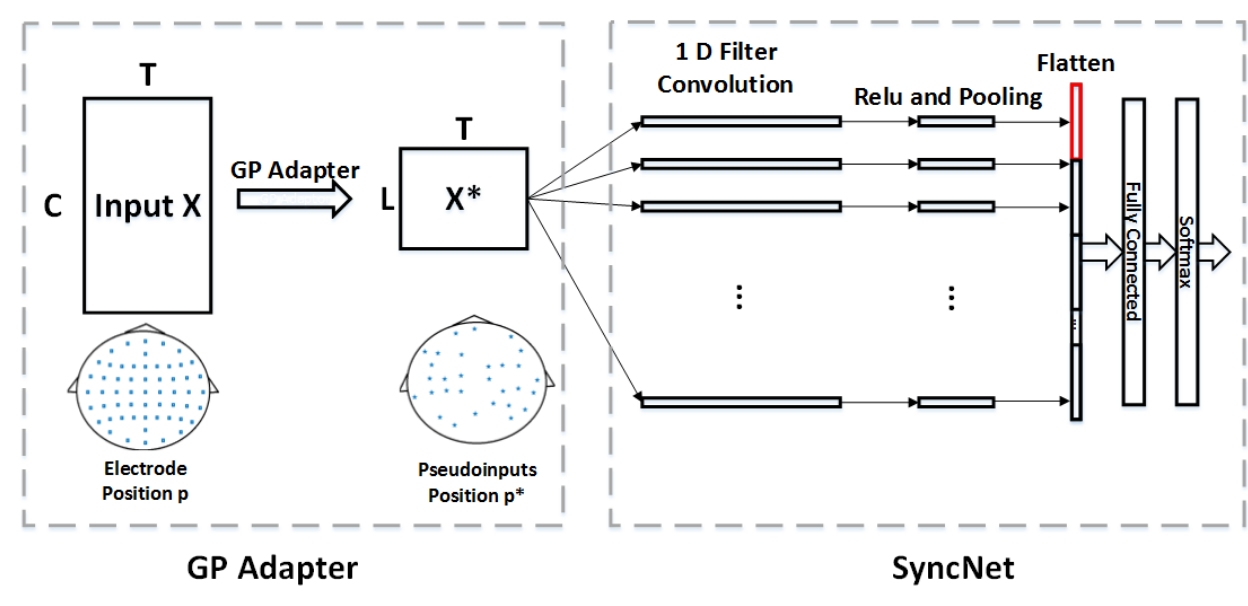braindecode.models.SyncNet#
- class braindecode.models.SyncNet(n_chans=None, n_times=None, n_outputs=None, chs_info=None, input_window_seconds=None, sfreq=None, num_filters=1, filter_width=40, pool_size=40, activation=<class 'torch.nn.modules.activation.ReLU'>, ampli_init_values=(-0.05, 0.05), omega_init_values=(0.0, 1.0), beta_init_values=(0.0, 0.05), phase_init_values=(0.0, 0.05))[source]#
Synchronization Network (SyncNet) from Li, Y et al (2017) [Li2017].
Interpretability

SyncNet uses parameterized 1-dimensional convolutional filters inspired by the Morlet wavelet to extract features from EEG signals. The filters are dynamically generated based on learnable parameters that control the oscillation and decay characteristics.
The filter for channel
cand filterkis defined as:\[f_c^{(k)}(\tau) = amplitude_c^{(k)} \cos(\omega^{(k)} \tau + \phi_c^{(k)}) \exp(-\beta^{(k)} \tau^2)\]where: - \(amplitude_c^{(k)}\) is the amplitude parameter (channel-specific). - \(\omega^{(k)}\) is the frequency parameter (shared across channels). - \(\phi_c^{(k)}\) is the phase shift (channel-specific). - \(\beta^{(k)}\) is the decay parameter (shared across channels). - \(\tau\) is the time index.
- Parameters:
num_filters (int, optional) – Number of filters in the convolutional layer. Default is 1.
filter_width (int, optional) – Width of the convolutional filters. Default is 40.
pool_size (int, optional) – Size of the pooling window. Default is 40.
activation (nn.Module, optional) – Activation function to apply after pooling. Default is
nn.ReLU.ampli_init_values (tuple of float, optional) – The initialization range for amplitude parameter using uniform distribution. Default is (-0.05, 0.05).
omega_init_values (tuple of float, optional) – The initialization range for omega parameters using uniform distribution. Default is (0, 1).
beta_init_values (tuple of float, optional) – The initialization range for beta parameters using uniform distribution. Default is (0, 1). Default is (0, 0.05).
phase_init_values (tuple of float, optional) – The initialization range for phase parameters using normal distribution. Default is (0, 1). Default is (0, 0.05).
Notes
This implementation is not guaranteed to be correct! it has not been checked by original authors. The modifications are based on derivated code from [CodeICASSP2025].
References
[Li2017]Li, Y., Dzirasa, K., Carin, L., & Carlson, D. E. (2017). Targeting EEG/LFP synchrony with neural nets. Advances in neural information processing systems, 30.
[CodeICASSP2025]Code from Baselines for EEG-Music Emotion Recognition Grand Challenge at ICASSP 2025. SalvoCalcagno/eeg-music-challenge-icassp-2025-baselines
Methods
- forward(x)[source]#
Forward pass of the SyncNet model.
- Parameters:
x (torch.Tensor) – Input tensor of shape (batch_size, n_chans, n_times)
- Returns:
out – Output tensor of shape (batch_size, n_outputs).
- Return type: